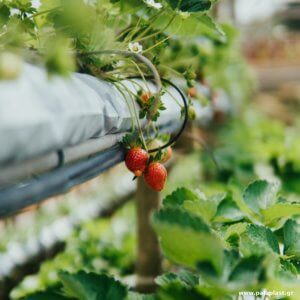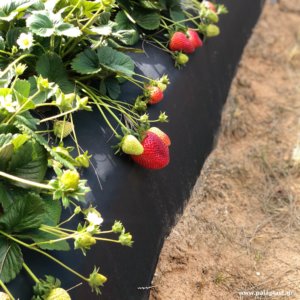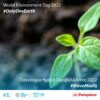STRAWBERRY
- Scientific name: Fragaria sp., of the Rosaceae family, was known from ancient times as wild strawberry.
- Commercial strawberry cultivation began in the Brittany region in 1750 from the crossing of three wild strawberry varieties. This crossing gave the hybrid Fragaria x anannasa Duch., which replaced in commercial production the forest strawberry (Fragaria vesca), which had been the first species in the early 17th century attempt at systematic cultivation.
- According to the FAO, global strawberry production reached 8.9 million tonnes in 2019. China is the largest producing country, holding about 40% of the world production. Significant percentages of world production are achieved by countries such as: the United States of America and Mexico followed by countries such as: Egypt, Turkey, Spain and Poland.
- Strawberries are composed mainly of water (91%) and carbohydrates (7.7%), with small amounts of protein (0.7%) and fats (0.3%). They are a very good source of vitamin C; contain significant amounts of manganese, folic acid (vitamin B9 – important for normal tissue growth and cell function) and potassium (involved in many basic body functions, such as regulating blood pressure). The health benefits of consuming them are therefore multiple and include reduced cholesterol, reduced blood pressure, significant antioxidant activity, limiting fluctuations in blood sugar and insulin levels, and overall they are an excellent addition to a healthy diet.
- The strawberry is a plant with a shallow root system, with 90% of its roots growing to a depth of 15-20 cm. It grows well in a variety of soils, but it grows best in light to medium soils with a pH of 5.5 to 6.5, which are rich in organic matter, well drained and low in calcium.
- Strawberries can be grown in various ways, depending on the conditions: outdoors or under cover in: low tunnels, half-height greenhouses with side windows, greenhouses as a hydroponic crop.
STRAWBERRY IRRIGATION
A key factor for the good yield and production of strawberry plants is rational watering. Strawberries are demanding in terms of soil moisture, but attention is required in the amount of water supplied due to the plants’ superficial root system. Particular attention should be paid to excessive irrigation in the first 2 weeks after planting, because during this period the plants have a very limited root system and there is a risk of suffocation or loss of nutrients. Similar attention is required when watering during the flowering-fruiting stage, as lack of moisture results in the fall of flowers, while excessive irrigation can cause root suffocation as well as development of soil diseases. It should be noted that the water needs vary depending on the climatic conditions and the way of cultivation, while in general drip irrigation with a discharge of 2-3 liters/hour at distances not greater than 30 cm from each other is used for the irrigation of strawberry plantations.


Palaplast has a wide range of products that can be used to install a reliable and efficient irrigation system whatever the method of growing strawberries:
- Pressure Compensating Driplines – (Paladrip-FC – Palaplast), Driplines – (Paladrip – Palaplast, Paladrip-XL – Palaplast)
- Dripline Fittings – (Dripline Fittings – Palaplast)
- Drip Tape – (Paladrip-Tape – Palaplast)
- Drip Tape Fittings – (Drip Tape – Palaplast)
While in the case of hydroponic cultivation:
- LDPE Irrigation Pipes – (LDPE – Palaplast) – ‘Super Pal’ 6Atm in black or white color.
- Self-Compensating Drippers – (Self Compensating – Palaplast ) such as: “AGRAS – SC/ND”, “AXIOS – SC”, “MEDOUSA – SC”.
- Microtubes – PE & PVC – (Microtubes – Palaplast) such as: “PVC Microtube F5”, “Microtube Dripper Hose F3.2”.
- Drippers Accessories – (Accessories – Palaplast) such as: “Support Spike 30°”, “Dripper Spike 30°”, “Distribution Manifold”, “Snap Fit”.
- Mini Valves – (Mini Valves – Palaplast)



